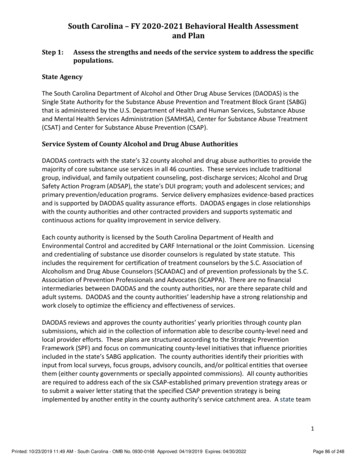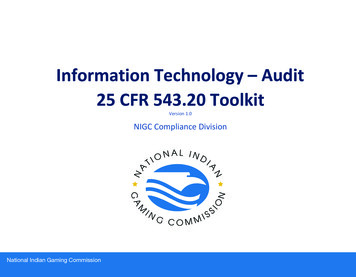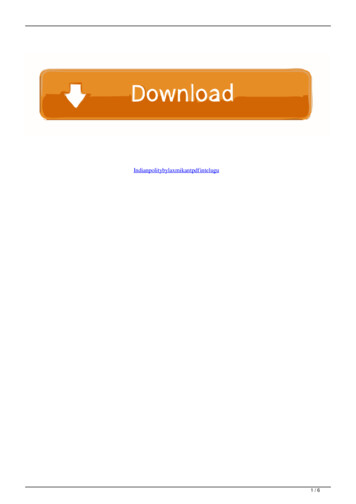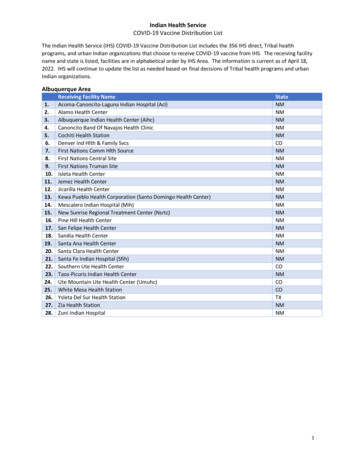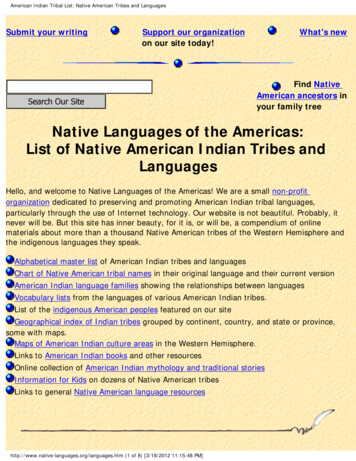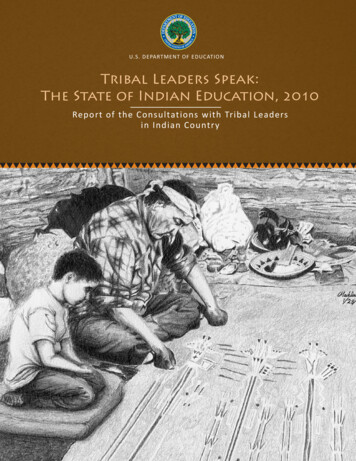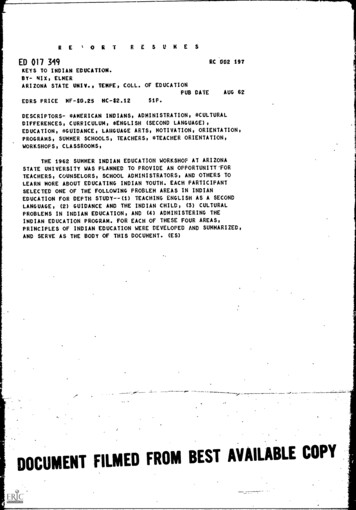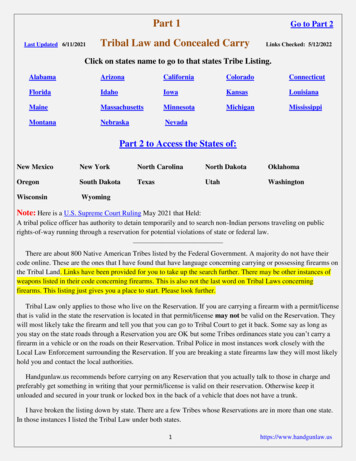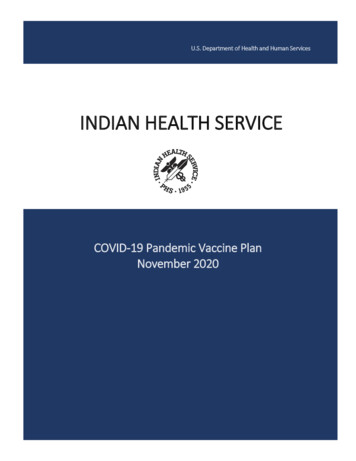
Transcription
U.S. Department of Health and Human ServicesINDIAN HEALTH SERVICECOVID-19 Pandemic Vaccine PlanNovember 2020
IHS COVID-19 Pandemic Vaccine Plan November 2020Table of ContentsIntroduction . 3Tribal Consultation and Urban Confer . 3The IHS COVID-19 Vaccine Task Force . 4Section 1: Vaccine Availability . 7Section 2: Prioritization . 11Section 3: Vaccine Distribution and Ordering . 13Section 4: Vaccine Administration . 18Section 5: Communications. 21Section 6: Data Management. 22Section 7: Safety and Monitoring. 26Resources . 28Appendix A: CDC Phase 1 Planning Scenarios . 29Appendix B: I/T/U Facility Pre-Planning Tool. 35Appendix C: IHS COVID-19 Facility Planning Checklist - EXAMPLE . 36Appendix D: CDC Data Requirements for COVID-19 Vaccine Monitoring . 41
IntroductionThe COVID-19 pandemic has disproportionately affected American Indian/Alaska Native (AI/AN)populations across the country, with infection rates over 3.5 times higher than non-Hispanic whites1. Inaddition, AI/AN individuals are over four times more likely to be hospitalized as a result of COVID-19 2. Inaddition to many public health measures in place, such as social distancing, mandatory curfews andclosures, mask wearing and handwashing, COVID-19 vaccination remains the most promising interventionto further reduce disease, morbidity, and mortality in AI/AN people.The Indian Health Service (IHS) supports the planning and monitoring of the IHS response to COVID-19including COVID-19 vaccine distribution, allocation, and implementation. For the COVID-19 vaccine to besuccessful in allocation, distribution, administration, documentation, and monitoring, a system wideplanning effort is needed immediately to be ready to implement vaccination activities as soon as a Foodand Drug Administration (FDA) approved vaccine is available.On September 16, 2020, the Centers for Disease Control and Prevention (CDC) issued guidance to ensurejurisdictions develop and implement a comprehensive vaccination plan. The CDC’s COVID-19 VaccinationInterim Playbook for Jurisdiction Operations, covers many areas of vaccination program planning forjurisdictions, including IHS and CDC Immunization and Vaccines for Children Cooperative Agreementfunding recipients. Under the CDC COVID-19 Vaccination Program, jurisdictions are required to addressplaybook requirements, describe their responsibility for ensuring activities are implemented, and submitplans to the CDC.This IHS COVID-19 Pandemic Vaccine Plan November 2020 details how the IHS health care system willprepare for and operationalize a vaccine when it becomes available. This plan includes an overview ofthe IHS Vaccine Task Force and is divided into seven sections. Each section includes activities,assumptions, and specific actions IHS will take to coordinate vaccine distribution. The activities andactions identified in this document are essential in coordinating the health care system response, andadditional items may be added to fit local needs. This plan provides important guidance for all IHS DirectService facilities and Tribal health programs and Urban Indian Organizations (I/T/U) that choose to receiveCOVID-19 vaccine coordinated through IHS.This plan is based on currently available information. IHS will continue to assess, respond, and adaptfederal guidance as new information becomes available regarding vaccine developments, vaccine storagerequirements, risk groups, and prioritization recommendations by researchers and guidance bodies.Tribal Consultation and Urban ConferOn September 24, 2020, the United States (U.S.) Department of Health and Human Services (HHS)initiated tribal consultation on COVID-19 Vaccination Planning for Indian Country. HHS hosted six regionalconsultations during the period of September 28 through October 1, 2020. On September 25, 2020, IHSalso initiated Urban Confer on COVID-19 Vaccination Planning for Indian Country. The deadline forwritten tribal consultation and urban confer comments was on October 9, 2020. On October 14, 2020,1COVID-19 Among American Indian and Alaska Native Persons — 23 States, January 31–July 3, 2020 Weekly /August 28, 2020 / 69(34);1166–1169 m2Hospitalization rates per 100,000 population by age and race and ethnicity — COVID-NET, March 1, 2020–September 5, 2020. ta/covidview/index.htmlIHS COVID-19 Pandemic Vaccine Plan November 20203
IHS initiated tribal consultation and urban confer to seek input on the IHS COVID-19 Pandemic VaccineDraft Plan. The deadline for written comments closed on October 21, 2020. The IHS Vaccine Task Forceteams reviewed all edits and comments received on the draft plan. The input received is incorporatedinto the IHS COVID-19 Pandemic Vaccine Plan November 2020; as appropriate.The IHS vaccine plan and distribution strategy align with CDC recommendations with advice from the CDCAdvisory Committee on Immunizations Practice (ACIP) and National Academies of Sciences, Engineering,and Medicine (NASEM) for priority populations.The IHS COVID-19 Vaccine Task ForceIn early March 2020, IHS senior leadership activated the Headquarters Incident Command Structure (ICS)to respond to COVID-19. On September 4, 2020, the ICS approved the IHS COVID-19 Vaccine Task Force(VTF) to lead the Agency’s COVID-19 vaccine activities. The VTF is under the direction of the IHS IncidentCommand Operations Officer/Chief Medical Officer, a VTF Lead and two co-leads, and includesrepresentatives from headquarters, Areas, and Service Units. The VTF is comprised of broad clinicalfederal employee representation and is established in accordance with the Federal Advisory CommitteeAct.The VTF guides the guide development of action plans and is comprised of six teams focused on vaccineadministration, communications, data management, safety and monitoring, distribution, andprioritization. The VTF Lead reports to IHS Incident Command Operations Officer to share updates,communicate priorities, and address barriers. A few IHS Areas have also established their own respectivevaccine task forces, resulting in strengthened distribution preparedness activity at the Area level.Prioritization TeamThis team is led by an Epidemiologist and includes the Office of Public Health Support, Office of HumanResources, and others. Role and scope: Engage I/T/Us to collect critical and target population estimatesfor early phase COVID-19 vaccine distribution utilizing guidance from the CDC, CDC’s ACIP, and NASEM.The vaccine needs will be informed by the population estimates determined by I/T/U facilities. Provideguidance and technical assistance for I/T/Us to develop plans for ensuring equitable allocation of COVID19 vaccine across IHS. Collaborate with other VTF teams to inform distribution, reporting and datamanagement, and ensure transparent communication.IHS COVID-19 Pandemic Vaccine Plan November 20204
Distribution and Allocation TeamThis team is led by NSSC and includes the National Pharmacy and Therapeutics Committee (NPTC), Officeof Quality, Office of the General Counsel (OGC), Prioritization Team, Area Point of Contacts, and others.Role and scope: Identify anticipated I/T/U facilities desiring vaccine distribution from IHS. Identify tribaland urban preference for IHS, state or local public health vaccine allocation. Promote transparency andopen communication between IHS, Tribes, and states to ensure every I/T/U facility with which NSSC iscoordinating vaccine distribution has a source of distribution. Identify and procure resources, such asvaccine storage and monitoring supplies and additional protective personal equipment (PPE) for vaccineadministration. Work with CDC to ensure end to end inventory, tracking and ordering systems for COVID19 vaccine are operational and accessible to I/T/U facilities prior to distribution of the vaccine. AssureI/T/U facilities receive ongoing and timely information regarding vaccine availability, distribution, accessprocedures, and reporting requirements for ongoing receipt of vaccine. Advocate for delivery directly toend user. Plan for three phases of vaccine distribution (limited, large distribution, continuedvaccination/shift to routine strategy).Vaccine Administration TeamThis team is led by the Office of Clinical and Preventive Services (OCPS) and includes the NationalCouncil of Chief Medical Officers (NCCMO), National Pharmacy Council (NPC), National Nurse LeadershipCouncil (NNLC), Pharmacist Expanding Vaccine Access (PEVA), and others. Role and scope: Developresources and tools to assist I/T/U facilities in vaccine administration and documentation. Developresources and sample documents that can be tailored to each I/T/U facility’s needs. Provide eventplanning strategies for various vaccination events (e.g., drive-up). Collaborate with Data Managementand Prioritization Teams to develop electronic tools and resources for identifying priority group lists, notetemplates, and coverage rate reports. Identify interdisciplinary workforce of nursing, public healthnursing, pharmacy, and providers at National, Area and I/T/U facilities NSSC is coordinating vaccinedistribution to support I/T/U facility efforts. Collaborate with Communication team to develop clinicalcommunication lines to channel information for support to clinicians and vaccinators.Communication TeamThis team is led by Public Affairs Staff and includes the NCCMO, NPC, NNLC, and others. Role and scope:Work with internal departments, Tribes, and external partners, to develop key messages that areculturally appropriate. Coordinate internal and external communication. Develop a strategiccommunication plan for IHS COVID-19 vaccine allocation and distribution for internal and externalaudiences. Work with the Vaccine Administration Team and the Safety and Monitoring Team to provideI/T/U facilities clinical information to make informed decisions regarding specific vaccine products.Announce major milestones. Identify audiences and coordinate with stakeholders. Develop talking pointsfor senior leadership regarding the VTF and IHS COVID-19 vaccine plan. Create vehicles to use formessaging.Data Management TeamThis team is led by the Office of Information Technology (OIT) and includes Area Clinical ApplicationCoordinators (CAC), Resource and Patient Management System (RPMS) advisory group, and others. Roleand scope: Identify solutions to track and document COVID-19 vaccine, including vaccine administrationdata, reporting of inventory and ordering processes. Dedicate resources for I/T/U facilities with whichNSSC is coordinating vaccine distribution to ensure export of data to IHS and the CDC according to therequired data reporting elements for COVID-19 vaccine. Utilize CDC supported platforms for use as aparallel pathway for I/T/U facilities needing alternate documentation processes. Advise Area Offices, andIHS COVID-19 Pandemic Vaccine Plan November 20205
I/T/U facilities on data management strategies to document, track, and monitor vaccine. Provideinformation technology support to I/T/U facilities to implement necessary upgrades and infrastructure forCDC reporting.Safety and Monitoring TeamThis team is led by the IHS NPTC in collaboration with the NSSC, the IHS Division of Patient Safety andClinical Risks Management (Office of Quality), Division of Epidemiology and Disease Prevention (Office ofPublic Health Support), and the IHS ACIP Liaison. Role and scope: Provide field-level education to I/T/Ufacilities regarding adverse vaccine event (AVE) monitoring & reporting processes, clinical review &guidance for FDA-authorized/approved vaccines, AVE active surveillance of sentinel sites and passivesurveillance via Vaccine Adverse Event Reporting System (VAERS). Conduct AVE analysis for the IHSservice population, and report results to key stakeholders.IHS COVID-19 Pandemic Vaccine Plan November 20206
Section 1: Vaccine AvailabilityThe COVID-19 vaccine is anticipated to be released in three phases based on vaccine approval by the FDAand availability, moving from targeted to broader populations. The IHS vaccine distribution and allocationwill align with guidance provided from CDC, ACIP, and NASEM for priority populations. The earliestapproved COVID-19 vaccine may be available in November 2020 with limited supplies. Vaccine supply isanticipated to increase substantially in 2021. Initial COVID-19 vaccines will either be approved as licensedvaccines or authorized for use under an Emergency Use Authorization (EUA) issued by the FDA. The CDCproposes early phase vaccine distribution to include 40 million vaccine doses by the end of December2020.IHS recognizes the sovereign authority of Tribal nations to provide for the welfare of its people. I/T/U facilities shall determine their population estimates with guidance from CDC, ACIP andNASEM. An I/T/U facility’s population estimates can be different from their Indian Health Serviceuser population and may include non-American Indian/Alaska Native individuals. Upondetermination of its population estimates, the I/T/U facilities will coordinate with IHS to assurethe appropriate type and quantity of vaccine are allocated. IHS developed a pre-planning tool(See Appendix B) to allow I/T/U facilities to provide their population estimates and priority groupnumbers to inform vaccine allocation efforts. I/T/U facilities shall determine their priority groups when there are limited vaccine resources.I/T/U facilities may deviate from CDC/ACIP prioritization groups to immunize under otherpriorities that meet the spirit of the CDC/ACIP designated priorities within allocations ofCOVID-19 vaccine received. In the event more than one vaccine is approved for use and available, I/T/U facilities shall be ableto determine which vaccine or vaccines it chooses to receive and administer to its population.IHS shall distribute vaccine per I/T/U choices as vaccine is available.It is anticipated initial FDA approved COVID-19 vaccines will be two-dose series, separated by 21 to 28days. I/T/U facilities receiving their vaccine distribution through IHS should account for each vaccinatedperson to receive two doses of the same brand of COVID-19 vaccine, as brands are not interchangeable.Current recommendations are to fully vaccinate initial populations before expanding to additional targetpopulations. IHS planning assumptions for the three phases of COVID-19 vaccine distribution, assuggested by the CDC: Phase 1: Limited Doses Availableo Doses available per month constrained.o Highly targeted administration required to achieve coverage in priority populationsdetermined by the I/T/U facilities; facilities may deviate from CDC/ACIP prioritizationgroups to immunize under other priorities that meet the spirit of the CDC/ACIPdesignated priorities within allocations of COVID-19 vaccine received. o Vaccine administered in closed settings specific to priority group.Phase 2: Large Number of Doses Availableo Likely sufficient supply to meet demand.o Supply increases access.o Broad administration network required including surge capacity.o Expand beyond initial populations.o Administration through commercial and private partners.IHS COVID-19 Pandemic Vaccine Plan November 20207
o Administer through public health sites.Phase 3: Continued Vaccination, Shift to Routine Strategyo Likely excess supply.o Broad administration network for increased access.o Administration through commercial and private partners.o Maintain public health site where required.Figure 1: CDC Recommended Vaccine Phase downloads/COVID-19-Vaccination-Program-Interim Playbook.pdfKey Activities - Pre-Planning before Vaccine Availability1. Prioritization With I/T/U facilities, identify AI/AN priority groups using available information from CDC,ACIP, and NASEM for guidance. Develop tools to facilitate estimating the size of priority populations once identified.Standardization of the process for estimating population sizes may help to uphold thecommitment to equitable distribution of vaccine across all IHS. Engage I/T/Us, and federalpartners in all phases of development of a final distribution process ensuring transparency,equity, and respect for Tribal sovereignty.2. Distribution and Allocation Collaborate with CDC to identify strategy for de-centralized vaccine distribution. IHS NSSC will utilize Vaccine Tracking System (VTrckS) through CDC for coordinated vaccineordering.IHS COVID-19 Pandemic Vaccine Plan November 20208
Discuss with CDC vaccine allocation process for jurisdictions, ensuring equitable allocation forI/T/U facilities who are coordinating vaccine distribution through NSSC.Identify COVID-19 vaccine ordering platform and process for I/T/U facilities with which NSSCwill be coordinating vaccine distribution.Plan for managing vaccine waste, loss and returns.Coordinate process for breaking down vaccine orders for redistribution, if needed for smallersites.Assign roles and responsibility at NSSC for managing COVID-19 vaccination orders, allocation,returns/losses, storage/handling, and questions.Distribute educational information as available about vaccine distribution and ordering.3. Vaccine Administration Establish framework for reporting vaccine administration data both internal and externalfacing. Evaluate templates and resources for vaccine administration for I/T/U facilities with whichNSSC is coordinating vaccine distribution response. Develop templates and resources for vaccine administration.4. Communication Establish a COVID-19 vaccine communications plan including identifying external and internalaudiences, identifying communication tools and platforms. Update website content to include COVID-19 vaccine information and resources. Plan public education campaign that is culturally appropriate.5. Data Management Complete a gap analysis of capacity and capability of I/T/U facilities with which NSSC iscoordinating vaccine distribution to report CDC required data. Connect with CDC partners to review CDC platforms (ex. Vaccine AdministrationManagement System [VAMS] and Immunization [IZ] Gateway) and confirm IHS connectivity. Establish framework for standard vaccine coverage and summary statistics/analytics forstakeholders as appropriate. Assure that data management systems are operational, and that I/T/U facilities are onboarded to the critical data flows and electronic systems in advance of vaccine distribution. Assist I/T/U facilities with information technology support when needed to ensure requiredreporting elements.6. Safety and Monitoring Develop and implement system-wide education regarding IHS-specific VAERS reportingprocesses and other pharmacovigilance strategies prior to vaccine distribution. Establish pharmacovigilance workflow and processes for adverse eventmonitoring/surveillance, analysis, and reporting.Phase 1: Limited Doses AvailableDistribution and Allocation Team Apply allocation plan to distribution process.IHS COVID-19 Pandemic Vaccine Plan November 20209
Process vaccine orders based on CDC allocations.Focus distribution to closed settings serving critical/target populations as defined by I/T/Ufacilities in Phase 1.Generate and share standard summaries of doses distributed data.Respond to issues regarding vaccine in the field (ex. recalls, expiration dates, disposal).Provide guidance to redistribute doses to smaller or more remote I/T/U facilities withinreasonable geographic distances or areas.It is anticipated initial FDA approved COVID-19 vaccines will be two-dose series, separated by21 to 28 days. I/T/U facilities receiving their vaccine distribution through IHS should accountfor each vaccinated person to receive two doses of the same brand of COVID-19 vaccine, asbrands are not interchangeable. Current recommendations are to fully vaccinate initialpopulations before expanding to additional target populations.Communication Team Promote awareness of vaccine risks and benefits, dispel misinformation, and address publicconcerns about safetyData Management Team Maintain connection with IZ Gateway. Maintain accurate data on vaccine distribution and administration. Comply with CDCguidance for submission of data. Generate and share immunization coverage and doses administered reports. Provide ongoing technical support for I/T/U facilities to ensure data reporting is meeting CDCrequirements.Safety and Monitoring Team Conduct active (sentinel sites) and passive (VAERS) adverse vaccine event surveillance withdata analysis and reporting to key stakeholders. Report and distribute urgent safety-related messages in a timely manner to I/T/U facilities.Phase 2: Large Number of Doses Available Continue all steps listed above in ‘Limited Doses Available’ phase. Distribute vaccine broadly to I/T/U facilities with which NSSC is coordinating vaccine distributionto increase access to the vaccine.Phase 3: Continued Vaccination, Shift to Routine Strategy Continue vaccination response as appropriate. Incorporate distribution and use of COVID-19 vaccine into existing immunization program underOffice of Public Health Support, Division of Epidemiology Disease Prevention.IHS COVID-19 Pandemic Vaccine Plan November 202010
Section 2: PrioritizationEnsuring an equitable and transparent distribution plan when vaccine is available is a priority for IHS.Collecting and documenting population estimates from I/T/U facilities will inform COVID-19 vaccinedistribution plans. As of early November 2020, final ACIP recommendations have not been released forpriority populations for vaccination when supplies are limited. Health Care Personnel (HCP) have beenidentified as the likely Phase 1-a population that will receive the first 20-40 million vaccine doses in theU.S., as shown above in Figure 1. Additional priority groups may include essential workers, high riskindividuals who have underlying medical conditions, those aged 65 years or some combination (e.g.,essential workers 65 and older or who have one or more high risk medical conditions). Residents incongregate living facilities such as long-term care facilities and jails may also be prioritized.IHS has identified I/T/U facilities that will use the IHS NSSC for vaccine distribution and estimates for theamount of vaccine they will require. These estimates were reported by I/T/U facilities and will be used fordetermining the size of vaccine priority populations for IHS. IHS is working with I/T/U facilities to ensurethat the most accurate information available is used for identifying vaccine requirements and to ensurethat estimates provided by I/T/U facilities will be used.It is important to recognize the many unknowns that exist, for example, the efficacy of any given vaccinein patients of different ages or with certain conditions and how that might influence the ACIPprioritization considerations for a specific vaccine, the availability of any given vaccine or the acceptabilityof any vaccine to a given priority group. The VTF intends to navigate these issues using the best availablescientific data, guidance provided from CDC, ACIP, NASEM and in cooperation with leaders representingI/T/U facilities.Key Activities - VTF Prioritization Team Collect pre-planning information from I/T/U facilities including their determinations for prioritypopulations. If an I/T/U facility has not provided prioritization data, the VTF Prioritization Team will work withthe I/T/U to leverage existing systems in place to extract and report data to inform decisionsabout those at the highest risk for exposure, those who are essential workers, and thosevulnerable to experiencing severe outcomes. Standardize data collection and provide guidance on data sources, tools and existing reports toextract data and estimate numbers of high-risk individuals to guide use of early and limitedvaccine allocation in those I/T/U that need assistance. These include but are not limited toinformation from IHS Office of Human Resources, RPMS/EHR tools (iCARE, VGEN, QMAN reports)and national data warehouse (NDW). Assist Distribution Team in developing an allocation plan that ensures equity, especially whenvaccine is limited. I/T/U facilities receiving their vaccine distribution through IHS should account for each vaccinatedperson to receive two doses of the same brand of COVID-19 vaccine, as brands are notinterchangeable.Area Offices Designate an Area Vaccine Point of Contact (AVPOC) and Clinical Applications Coordinator (CAC)to assist in data collection and planning for I/T/U facilities with which NSSC is coordinating vaccinedistribution.IHS COVID-19 Pandemic Vaccine Plan November 202011
Offer assistance with prioritization if requested by I/T/U facilities with which NSSC is coordinatingvaccine distribution.I/T/U facilities with which NSSC will be coordinating vaccine distribution I/T/U facilities will develop their own, local process to determine needs, identify priority groupsand ensure equity. The final ACIP prioritization recommendations, which will be based on theNASEM framework and vaccine performance data, will be made available as a guide. I/T/U facilities will provide population estimates to AVPOC, who will submit to NSSC point ofcontact (POC).Population EstimatesThe estimates below are aggregated from pre-planning population estimates provided by I/T/U facilitieswho will be coordinating vaccine distribution through NSSC. Population Estimates are current as ofNovember 16, 2020.Critical PopulationHealthcare Personnel (Direct, non-direct, and emergency medical services)Essential workers (other emergency services, law enforcement, food andtransportation, teachers, childcare providers)Patients in tribal long-term care facilitiesEldersPatients at high-risk factors for COVID-19 illnessTotal people estimated to be vaccinated*Population Estimate43,783120,671*Total includes critical populations and young healthy adults (not reported in the table above).IHS COVID-19 Pandemic Vaccine Plan November 202076,311374,411894,2602,056,34712
Section 3: Vaccine Distribution and OrderingVaccine allocation and distribution information is evolving, and federal guidance will continue to informplanning for I/T/U facilities. During the COVID-19 pandemic, IHS and NSSC developed communication anddata collecting models for ordering and distributing personal protective equipment (PPE) and testingsupplies. These models will help inform planning for the COVID-19 vaccine. Tribal Health Programs andUIOs that choose to receive the COVID-19 vaccine through IHS, must complete a signed CDC COVID-19Vaccination Program Agreement - Vaccines Coordinated through IHS. These agreements include all CDCCOVID-19 vaccination program requirements.The VTF shall request and document I/T/U facilities’ priority group estimates (See Appendix B: I/T/U PrePlanning Tool) to establish a total number of vaccine doses for Phase 1. If there is not enough vaccine todistribute to each I/T/U facility’s priority populations, VTF will determine an equitable distributionmethodology to fulfill I/T/U facilities’ requests. For example, if the total number of vaccine doses neededto serve priority populations as reported by all I/T/U facilities is 100,000 but IHS only has 60,000 todistribute, then IHS multiplies each I/T/U facility’s requested amount by 60%.Once the number of I/T/U facilities receiving vaccine through IHS has been finalized, resources can beestimated by comparing projected vaccine allocations with I/T/U facility estimates for each targetpopulation in order to determine the proportion of the population that can be vaccinated and to identifyany potential deficits. It is anticipated initial FDA approved COVID-19 vaccines will be two-dose series,separated by 21 to 28 days. I/T/U facilities receiving their vaccine distribution through IHS should accountfor each vaccinated person to receive two doses of the same brand of COVID-19 vaccine, as brands arenot interchangeable. Current recommendations are to fully vaccinate initial populations beforeexpanding to additional target populations. IHS VTF will provide I/T/U facilities with updated vaccineavailability and CDC allocation information.The following categories apply to I/T/U facilities with which NSSC
prioritization. The VTF Lead report s to IHS Incident Command Operations Officer to share updates, communicate priorities, and address barriers. A few IHS Areas have also establish ed their own respective vaccine task forces , resulting in strengthened distribution pre paredness activity at the Area level.

